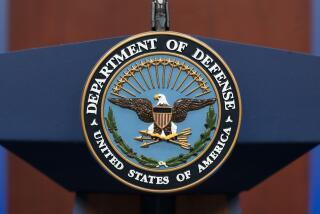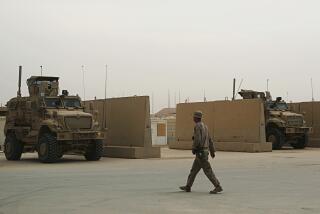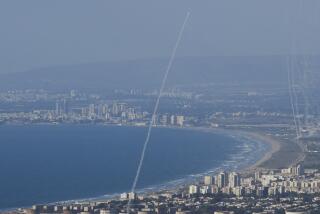Bush Rejects Appeasement as 1st U.S. Forces Land in Arabia : Deployment: The initial move of 4,000 troops is called strictly defensive, to thwart any Iraq attack. The possibility of long-term involvement is not ruled out.
WASHINGTON â President Bush said Wednesday that he sent U.S. fighting forces to Saudi Arabia because âAmerica will stand by her friends,â as combat aircraft and the first of what officials have said could be tens of thousands of troops took up defensive positions in the desert.
âWe must resist aggression or it will destroy our freedoms. Appeasement does not work,â the President declared in a somber, early-morning speech to the nation just hours after the first elite U.S. Army commando units arrived in the Middle East kingdom to fend off a possible attack by Iraq.
âA line has been drawn in the sand. The United States has taken a firm position,â Bush said later.
While declining to provide details of the size of the force they may eventually deploy, senior Pentagon officials sought to assure the nation they are dispatching sufficient troops, backed by some of the nationâs most lethal weapons, to thwart any offensive by Iraqi President Saddam Hussein.
âWe will put in adequate forces for the mission,â Gen. Colin L. Powell, chairman of the Joint Chiefs of Staff, said. The initial deployment was expected to be 4,000 troops, although officials have said the number ultimately could reach 90,000.
The mission is to protect Saudi Arabia and U.S. oil interests from the powerful, battle-hardened Iraqi military units massed to the north on Saudi Arabiaâs border with Iraqi-overrun Kuwait.
The Iraqis, Powell said, âare not invincible, and they are not 10 feet tall.â But he expressed concern that Iraq might resort to the use of dreaded chemical weapons. One U.S. official said satellite photographs taken Tuesday showed equipment that could contain chemical weapons being loaded on Iraqi aircraft. Powell said such a threat has been taken into account.
Bush said that the use of chemical weapons âwould be intolerable, and . . . it would be dealt with very, very severely.â
Neither Bush nor Defense Secretary Dick Cheney would estimate how long the U.S. forces would be stationed in the tense region. As the first soldiers took up positions at Saudi air bases, however, one U.S. official noted: âThere is a possibility of a long-term involvement.â
The sudden airlift of troops under cover of darkness and the rush of U.S. Air Force F-15 Eagles from bases in the eastern United States and Europe came six days after Iraqâs invasion of Kuwait. That lightning-like operation led U.S. officials, and leaders throughout the Middle East, to express deep alarm that Hussein would not stop at the Kuwaiti border in his quest to gain control of the wealth produced by some of the worldâs richest oil fields.
The Presidentâs action, announced in a nationally broadcast speech from the Oval Office, drew expressions of support from senior Democrats and Republicans in Congress. They agreed that the threat of Iraqi control of world oil supplies justifies the commitment of U.S. troops and military hardware.
Sen. Edward M. Kennedy (D-Mass.) praised Bush for having âskillfully worked with other nations to isolate Iraq and apply maximum diplomatic and economic pressure to reverse Iraqâs illegal seizure of Kuwait.â
âI think that the President can count upon our support in this action,â said Rep. William H. Gray III of Pennsylvania, the House of Representativesâ third-ranking Democrat.
With Kuwait apparently sealed off to the West by more than 100,000 occupying Iraqi troops, military activities there remained to some degree a matter of uncertainty.
âThereâs no sign of activity yet,â said a U.S. official on an interagency task force monitoring developments in Kuwait. âWeâre a bit surprised. Every day that they donât react, weâre closer to home.â
With U.S. troops taking up defensive positions at key posts in Saudi Arabia, said one Pentagon source, an attack could come ânow--in the next day or two--or never.â
U.S. intelligence sources reported that additional Iraqi troops and weapons were being moved toward that nationâs border with Kuwait. But they said there did not appear to be a major buildup of forces inside Kuwait.
In Baghdad, Hussein declared that Iraq had annexed Kuwait and called for Arab unity in the face of outside threats.
The Arab League planned to hold a summit today in Cairo, as U.S. officials continued to work behind the scenes to line up support among nations both in the region--where Hussein is alternately feared and viewed as an Arab brother--and throughout the rest of the world for a multinational display of military resolve.
The commitment of Egyptian troops, much favored by the United States, as well as units from Morocco, remained uncertain. Egyptian President Hosni Mubarak denied reports in the United States that his country had agreed to send troops to join the multinational force. He said the Arabs should deal with the situation themselves rather than have âa solution forced on us by foreign powers.â
But a ranking Egyptian official indicated that the summit meeting in Cairo would provide a display of Arab unity that would allow Egypt to dispatch troops to Saudi Arabia with sufficient political support from other Arab nations.
On Capitol Hill, Rep. Ike Skelton (D-Mo.), who attended a congressional briefing by Defense Secretary Cheney, said troops from other countries would be joining the U.S. forces in Saudi Arabia.
Skelton said he did not know which nations would be part of the multinational force, but that he assumed several would be Arab countries. âSaudi Arabia will make the announcement,â he added.
Meanwhile, U.S. Army units, along with Air Force fighters and three U.S. Navy aircraft carrier battle groups, moved into position to take up the brunt of the Middle East duties.
With the 82nd Airborne Divisionâs âready brigadeâ digging in after a 16-hour flight from North Carolina, several more U.S. units remained prepared for rapid deployment. The 101st Airborne Assault Division, equipped with hundreds of attack helicopters, was ready for deployment from Ft. Campbell, Ky., and the 24th Infantry Mechanized Division, based at Ft. Stewart, Ga., remained on alert for rapid departure, Pentagon officials said.
In addition, warplanes throughout the United States and Europe, including F-16s and F-111 fighter-bombers, were being prepared for deployment to Saudi air bases. And B-52 bomber units based in the United States were maintained on alert status for the long flights to the region. âOne of our functions is going to be using aircraft to kill tanks,â said Sen. Phil Gramm (R-Tex.) after a military briefing.
The Air Force readied several C-5A airlift aircraft, the behemoth of the serviceâs transport fleet, for the bulky equipment operated by the 24th and the 101st Divisions. The planes could ferry hundreds of the Armyâs heaviest tanks and helicopters to the region in less than a day, Pentagon officials said.
Navy sources said hospital ships were steaming toward the Persian Gulf from the Pacific Ocean. The aircraft carrier Eisenhower and its escorts of cruisers and destroyers were in the Red Sea, to the west of Saudi Arabia, and the carrier Independence and its battle group were in the Arabian Sea, just beyond the Strait of Hormuz and the Persian Gulf. In addition, the carrier Saratoga and the battleship Wisconsin were headed across the Atlantic toward the Mediterranean Sea.
In Moscow, Bushâs decision won the tacit approval of Soviet leaders, but they shied away from any hint that their armed forces might join a possible blockade to enforce the international economic and military embargo on Iraq approved Monday by the U.N. Security Council.
âOur navy is simply not equipped for this sort of operation,â said an official of the Soviet Communist Partyâs policy-making Central Committee. âHowever, I have no doubt that many of our captains, just like in America, are wringing their hands with eagerness to get involved.â
Still, a U.S. diplomat reported that an âenormous number of contactsâ were being made between American and Soviet colleagues to find ways to pressure Iraq to withdraw from Kuwait--a reflection of superpower cooperation that has amazed some Washington officials as they seek an end to the first international crisis of the post-Cold War era.
âNo one is raising the specter of World War III,â said one official involved in monitoring the crisis.
The massive military movements toward the troubled region, with the support of Saudi Arabia and other Arab nations, represented a breakthrough for U.S. efforts to establish closer and more open ties there despite four decades of American support for Israel.
Saudi acceptance of the U.S. role appeared to have been driven by its fear of Iraq and eased by a U.S. agreement to make an emergency sale of 15 F-15 jets to the Saudis. In the mid-1980s, Saudi Arabia purchased 12 of the sophisticated fighters but stationed them in the United States on a standby basis to replace planes as needed from an earlier purchase.
Under the Emergency Arms Sales Act, the White House may bypass Congress in order to rush arms to allies.
One source, well informed on affairs in Saudi Arabia, said King Fahd had not yet asked for any further arms. But it was believed that he would soon seek additional weaponry, most likely 40 to 48 F-15s. Such aircraft were denied to Saudi Arabia in 1985 when the American-Israel Public Affairs Committee raised objections.
At a midday news conference, Bush sought to lessen tensions caused by the detainment of 39 Americans in a Baghdad hotel.
But, he said, âI consider the protection of American life fundamental to my job and responsibilities.â
The State Department said it has compiled an incomplete list of 1,468 Americans in Kuwait or Iraq who have been prevented from leaving despite sharp official protests by U.S. diplomats.
Some Americans trapped in Kuwait and Iraq have managed to sneak over the borders, and U.S. diplomats in Baghdad have been allowed to visit with the Americans held in the hotel. They reported that the captives are in âgood spirits.â
The Presidentâs deployment of troops left some family members in this country angry, as the tension appeared to escalate and with it the increased risk that Hussein could use the Americans as hostages.
After nearly a week in which the nation saw relatively little of the President--save for brief comments to reporters as the frustration of the crisis grew--Bush twice presented his case for the deployment during a space of three hours, first in a nationwide speech and then in a news conference.
Speaking from his desk in the Oval Office at 6 a.m. PDT, Bush disclosed the deployment of the 82nd Airborne Division units and the fighter jets, âto assist the Saudi Arabian government in the defense of its homeland.â
He said the United States seeks âthe immediate, unconditional and complete withdrawal of all Iraqi forces from Kuwait,â and restoration of the Kuwaiti government that was replaced by a âpuppet regimeâ when Iraq invaded.
âThe stakes are high,â he said, because the United States depends on imported oil for half of its oil supplies. Iraqi control over Kuwait, and the threat to Saudi Arabia--both major oil producers--could jeopardize Americaâs economic independence, the President said.
Referring to Nazi Germanyâs takeover of Europe 50 years ago, Bush said: âAs was the case in the 1930s, we see in Saddam Hussein an aggressive dictator threatening his neighbors.â
Discounting the Iraqi presidentâs pledges first not to invade Kuwait and then to withdraw, Bush said, âHis promises mean nothing.â
âThis is not an American problem or a European problem or a Middle East problem,â the President said. âIt is the worldâs problem.â
He continued: âIraq may not stop using force to advance its ambitions. Iraq has massed an enormous war machine on the Saudi border, capable of initiating hostilities with little or no additional preparation. Given the Iraqi governmentâs history of aggression against its own citizens as well as its neighbors, to assume Iraq will not attack again would be unwise and unrealistic.â
Washington Bureau Chief Jack Nelson and staff writers William J. Eaton, Karen Tumulty and Robin Wright contributed to this report.
WORLD MILITARY REACTION
The world at large has agreed to enforce economic sanctions against Iraq; many nations also froze assets of Iraq and Kuwait. Others, including United States, have gone further. Hereâs a military roundup:
UNITED STATES: Sends combat aircraft and troops to region.
SAUDI ARABIA: Will allow U.S. troops and warplanes to be deployed from its land.
TURKEY: Expects U.S. request to use Turkish air bases as potential staging areas. Has stopped allowing Iraqi oil to be loaded on tankers.
EGYPT: President Mubarak will host Arab summit today. âWe are not preparing troops and there is no talk about this,â he says. âBut if we are asked to participate with Arab troops, I do not think Egypt would refuse.â
BRITAIN: Prime Minister Margaret Thatcher is only world leader to offer ships and planes for the force. Destroyer is already in Persian Gulf. Other members of 16-nation NATO military alliance and 12-nation European Community hold back on military commitments, for now.
ITALY: Agrees to let bases be used to help facilitate transport of troops and equipment and for logistic support.
SPAIN: Will allow United States to use four jointly operated military bases to support U.S. troops.
WEST GERMANY: Signals readiness to allow the U.S. military to use American facilities in West Germany as a âbasis for operationsâ for soldiers headed to Saudi Arabia.
GREECE: Gives permission for nine U.S. support planes to pass through Greek airspace en route to Persian Gulf.
FRANCE: Has two ships in Gulf of Oman and frigate with Exocet missiles en route.
SOVIET UNION: Has offered no immediate military support. Anti-submarine ship and destroyer dispatched from Indian Ocean toward area, but only to âensure safety of navigation of Soviet civilian vessels.â
DEPLOYMENT TO GULF REGION KC-135 tankers: Dispatched from U.S. to Torrejon, Spain, used to refuel F-15 aircraft while in flight. Saratoga battle group: Bound for Mediterranean from U.S. bases. Forrestal-class aircraft carrier. Saratoga: Battleship Wisconsin: possibly equipped with Tomahawk cruise missiles F-111B bombers: At least 14 on training maneuvers, Incirlik AFB, Turkey F-15 Eagle fighters: About 20 form First Tactical Fighter Wing, Langley AFB, Va. to norhthern Saudi Arabia, arriving Wednesday Equipped with air-to-air missiles. AWACS reconnaissance: Five dispatched to air base near Riyadh, Saudi Arabia B-52 bombers: Diego Garcia, Indian Ocean 82nd Airborne Division: One brigade of about 4,000 troops dispatched to Dhahran air base in Saudi Arabia Eisenhower battle group: Nimitz-class nuclear-powered aircraft carrier: Dwight D. Eisenhower Guided-missile cruiser: Ticonderoga Guided-missile destroyer: Scott Joint Task Force-Middle East: Command ship: LaSalle Guided-missile cruiser: Antietam Cruiser: England Destroyer: David R. Ray Guided-missile frigates: Robert G. Bradley and Taylor Frigates: Vandergrift, Rentz and Barbey Independence battle group: Forrestal-class aircraft carrier: Independence Guided-missile cruiser: Jouett Guided-missile destroyer: Goldsborough Frigates: Brewton and Reasoner Supply ships: Cimarron and Flint U.S. Bases Involved: 1. Ft. Stewart, Ga. 24th Inf. Division Mechanized (readied) 2. Ft. Campbell, Ky. 101st Airborne Division (readied) 3. Ft. Bragg, N.C. 82nd Airborne Division 4. Norfolk, Va. 5. Mayport, Fla. Britain has a destroyer in the Persian Gulf; and France has two ships in Gulf of Oman and frigate with Exocet missiles en route.
Source: Times Wire Services/Los Angeles Times
More to Read
Sign up for Essential California
The most important California stories and recommendations in your inbox every morning.
You may occasionally receive promotional content from the Los Angeles Times.











